Definitions of All Delivery Types with Description

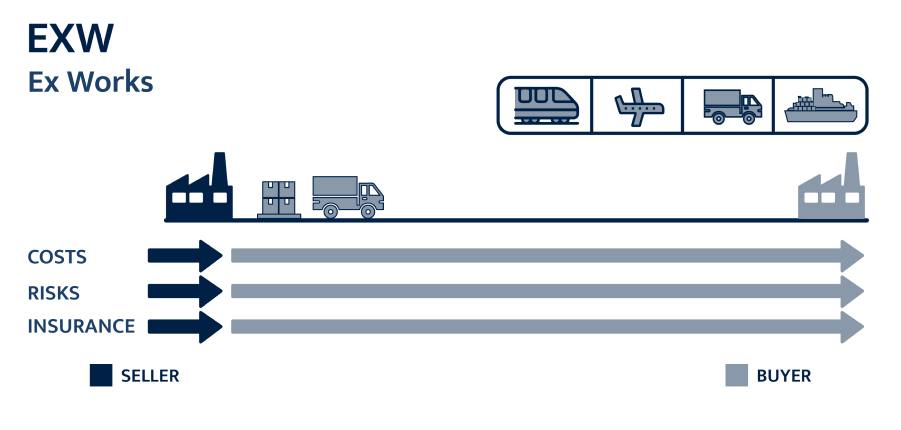
Under EXW, the seller minimizes its risk by only making the goods available at its premises or other named place (e.g., factory, warehouse, etc). The seller is not responsible for clearing the goods for export or loading them on the collecting vehicle. EXW term represents the minimum obligation for the seller. The buyer is responsible for all costs and risks involved in taking the goods from the seller’s premises, or other named place, to the final destination. This term may be used for all modes of transportation.
- Carriage to be arranged by the buyer.
- Risk transfers from the seller to the buyer when the goods are at the disposal of the buyer at the named place.
- Cost transfers from the seller to buyer when the goods are at the disposal of the buyer at the named place.
Note: If the parties wish the seller to bear the risk and cost for loading the goods on the collecting vehicle, as well as export clearance requirements, then the FCA term should be used.
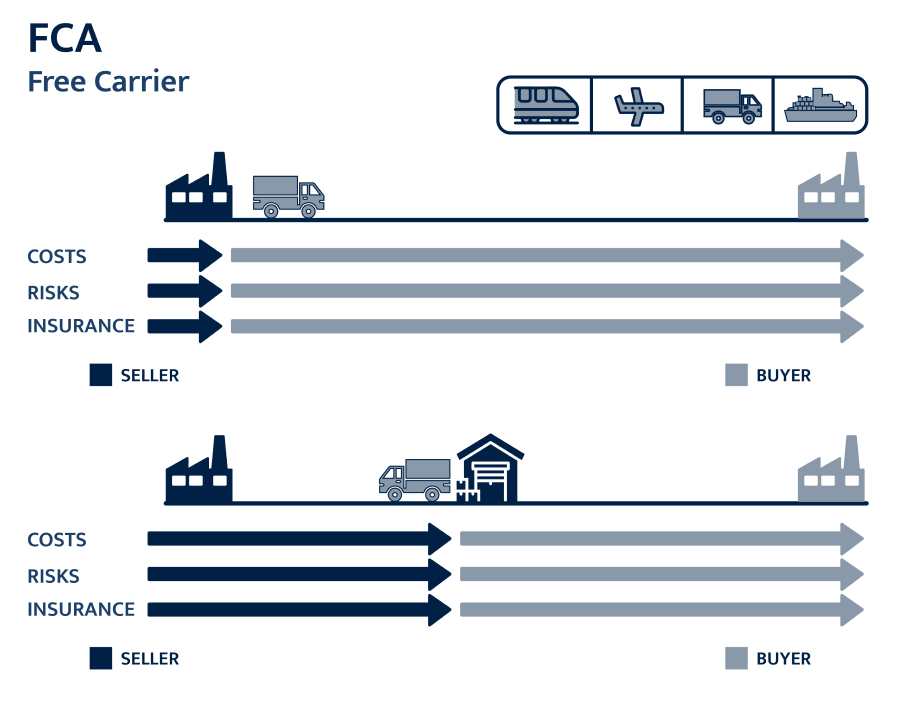
Under FCA, the seller arranges and pays for any pre-carriage up to a named place of delivery, unless otherwise agreed. The seller delivers the goods, cleared for export, to the carrier or another person nominated by the buyer at the seller’s premises or another named place. It should be noted that the chosen place of delivery has an impact on the obligations of loading and unloading of the goods. If the delivery occurs at the seller’s premises, the seller is responsible for loading the goods on the means of transport provided by the buyer. If the delivery occurs at any other place, the seller is not responsible for the unloading of the goods. This term may be used for all modes of transportation.
- Carriage to be arranged by the buyer or by the seller on the buyer’s behalf.
- Risk transfers from the seller to the buyer when the goods have been delivered to the carrier nominated by the buyer at the seller’s premises or another named place.
- Cost transfers from the seller to the buyer when the goods have been delivered to the carrier nominated by the buyer at the seller’s premises or another named place.
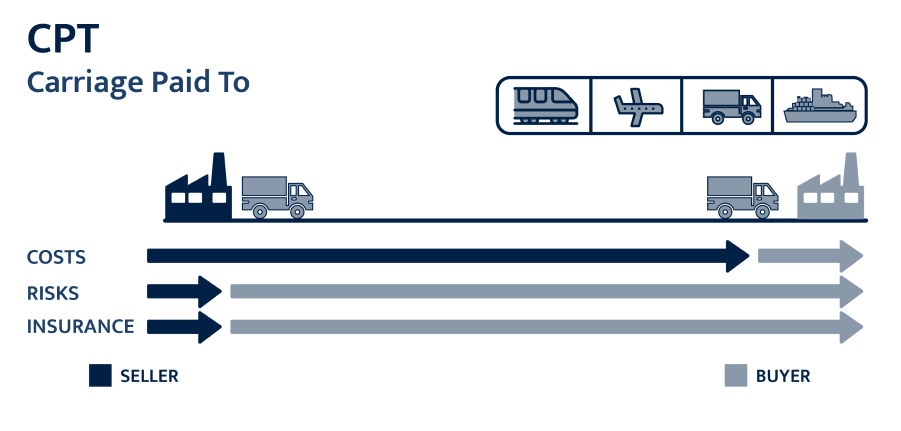
Under CPT, the seller arranges and pays for the main carriage to a named place/point of destination. The seller delivers the goods to the carrier of their choice, contracts for and pays all costs of carriage necessary to bring the goods to the named place of destination. This term has two critical points because risk passes and costs are transferred at different places. The risk of loss or damage to the goods passes from the seller to the buyer when the goods are handed over to the carrier, not when they reach the place of destination. If several carriers are used for the carriage, and the parties do not agree on a specific delivery point, then the risk for loss or damage to the goods transfers when they are delivered to the first carrier. This term may be used for all modes of transportation.
- Carriage to be arranged by the seller.
- Risk transfers from the seller to the buyer when the goods have been delivered to the carrier.
- Cost transfers from the seller to the buyer at the named place of destination.
Note: The buyer has the obligation to clear the goods for import, pay any import duty and carry out any import customs formalities.
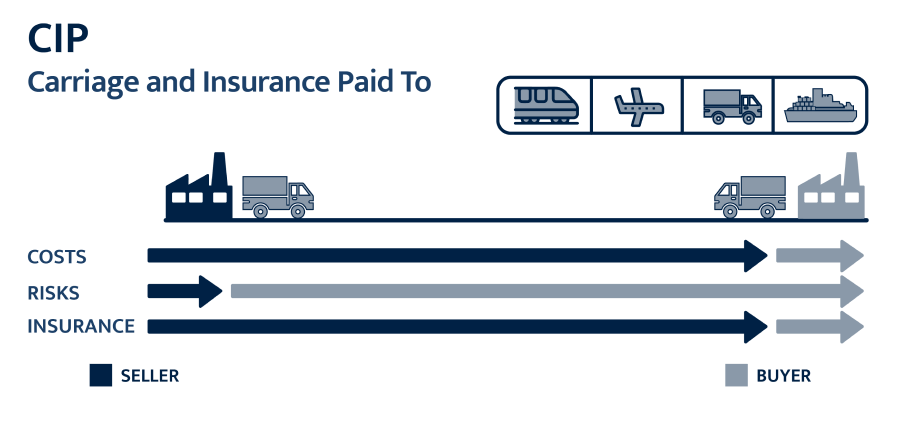
Under CIP, the seller arranges and pays for the main carriage to a named place/point of destination, as well as obtaining minimum coverage insurance. The seller delivers the goods to the carrier of their choice, contracts for and pays all costs of carriage necessary to bring the goods to the named place of destination. This term has two critical points because risk passes and costs are transferred at different places. The risk of loss or damage to the goods passes from the seller to the buyer when the goods are handed over to the carrier, not when they reach the place of destination. If several carriers are used for the carriage and the parties do not agree on a specific delivery point, then the risk for loss or damage to the goods transfers when they are delivered to the first carrier. Under the CIP term, the seller is responsible to procure minimum coverage insurance against the buyer’s risk of loss/damage to the goods during carriage. Should the buyer require greater insurance protection, they would either need to agree expressly with the seller or make its own extra insurance arrangements. This term may be used for all modes of transportation.
- Carriage and minimum insurance to be arranged by the seller.
- Risk transfers from the seller to the buyer when the goods have been delivered to the carrier.
- Cost transfers from the seller to the buyer at the named place of destination.
Note: The buyer has the obligation to clear the goods for import, pay any import duty and carry out any import customs formalities.
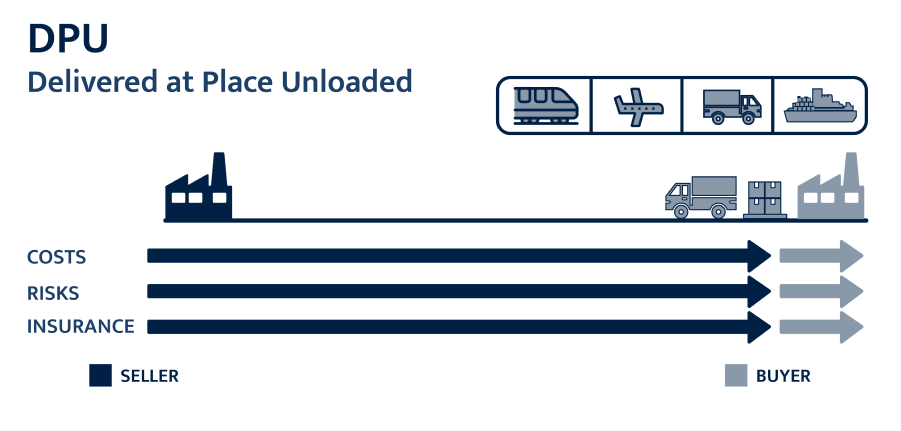
Under DPU, the seller undertakes to place the goods at the disposal of the buyer, unloaded from the arriving means of transport at a named terminal at a named port or place of destination. The seller delivers when the goods are unloaded from the arriving means of transport and placed at the disposal of the buyer at a named terminal at the named port or place of destination. “Terminal” includes any place, whether covered or not, such as a quay (wharf), warehouse, container yard or road, rail or air cargo terminal. The seller is not responsible for the import clearance. This term may be used for all modes of transport.
- Carriage to be arranged by the seller.
- Risk transfers from the seller to the buyer when the goods are placed at the disposal of the buyer, once unloaded at the named terminal and at the named port or place of destination.
- Cost transfers from the seller to the buyer when the goods are placed at the disposal of the buyer, once unloaded at the named terminal and at the named port or place of destination.
Note: The buyer has the obligation to clear the goods for import, pay any import duty and carry out any import customs formalities.
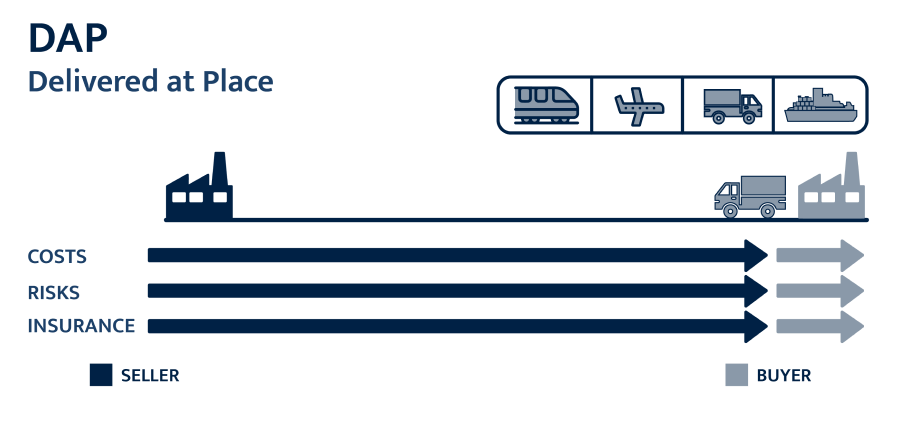
Under DAP, the seller undertakes to place the goods at the disposal of the buyer, ready for unloading from the arriving means of transport at a named place of destination. The seller delivers when the goods are placed at the disposal of the buyer at the named place of destination, but are not unloaded from the arriving means of transport. The seller is not responsible for the import clearance. This term may be used for all modes of transport.
- Carriage to be arranged by the seller.
- Risk transfers from the seller to the buyer when the goods are placed at the disposal of the buyer, but are not unloaded from the arriving means of transport at the named place of destination.
- Cost transfers from the seller to the buyer when the goods are placed at the disposal of the buyer, but are not unloaded from the arriving means of transport at the named place of destination.
Note: The buyer has the obligation to clear the goods for import, pay any import duty and carry out any import customs formalities.
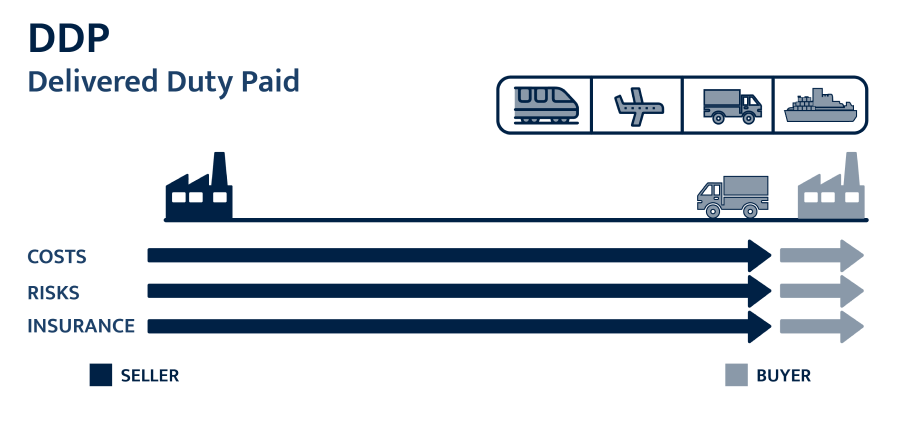
Under DDP, the seller undertakes to place the goods at the disposal of the buyer, cleared for import on the arriving means of transport and ready for unloading at a named place of destination. DDP represents the maximum obligation to the seller. The seller bears all costs and risks involved in bringing the goods to the named place of destination, with an obligation to clear the goods for import including any duty and carrying out all customs formalities. This term may be used for all modes of transport.
- Carriage to be arranged by the seller.
- Risk transfers from the seller to the buyer when the goods are placed at the disposal of the buyer, cleared for import but not unloaded from the arriving means of transport at the named place of destination.
- Cost transfers from the seller to the buyer when the goods are placed at the disposal of the buyer, cleared for import but not unloaded from the arriving eans of transport at the named place of destination.
Note: The DDP term should not be used if the seller is unable to obtain import clearance. If the parties wish the buyer to bear all risks and costs of import clearance, then the DAP term should be used.
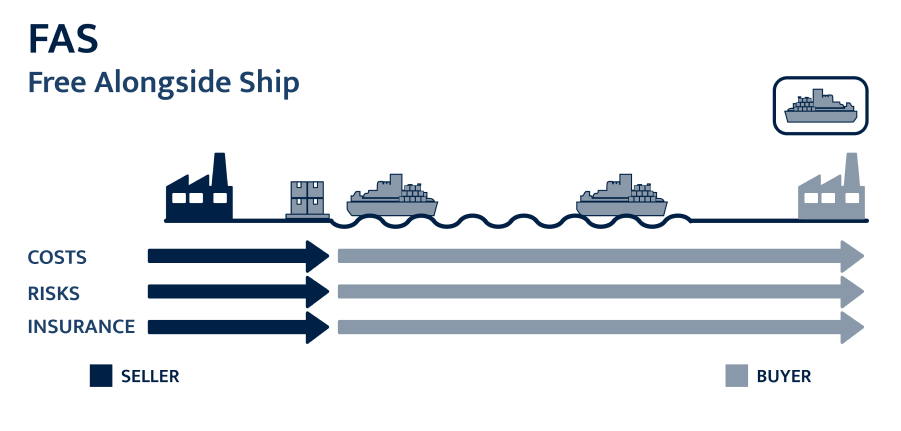
Under FAS, the seller undertakes to place the goods alongside the ship nominated by the buyer at a named port of shipment. The goods are delivered when the seller has placed the goods, cleared for export, alongside the vessel nominated by the buyer at the named port of shipment. The buyer bears all responsibility for costs and risks of loss or damage to the goods, once the seller has delivered the goods alongside the vessel. This term may only be used for goods that are being transported by sea or inland waterway.
- Main carriage to be arranged by the buyer.
- Risk transfers from the seller to the buyer when the goods have been placed alongside the ship nominated by the buyer at the named port of shipment.
- Cost transfers from the seller to the buyer when the goods have been placed alongside the ship nominated by the buyer at the named port of shipment.
Note: If the goods are containerized, it is typical for the seller to deliver the goods to the carrier at a terminal and not alongside the vessel. In this case, the FAS term would be inappropriate and the FCA term should be used.
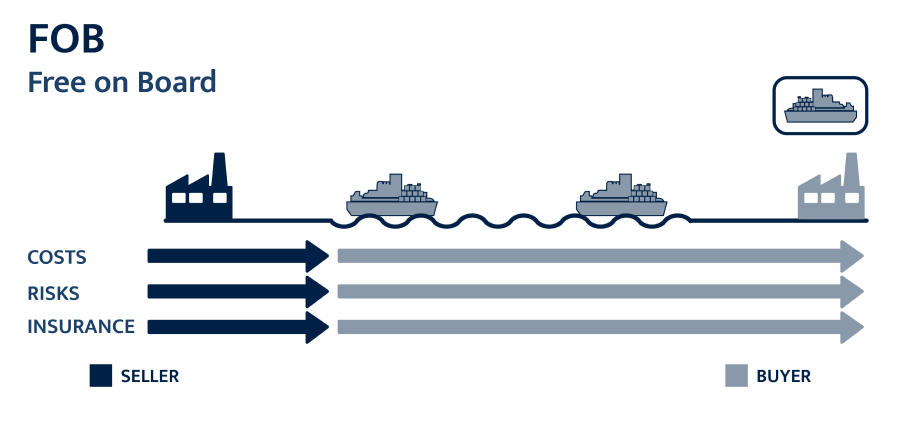
Under FOB, the seller undertakes to place the goods on board the vessel nominated by the buyer at a named port of shipment. The seller delivers the goods when they are loaded on the vessel nominated by the buyer at the named port of shipment. The buyer bears all costs and risks of loss or damage to the goods once they are loaded on board the vessel. The FOB term requires the seller to clear the goods for export. This term may only be used for goods that are being transported by sea or inland waterway.
- Main carriage to be arranged by the buyer.
- Risk transfers from the seller to the buyer when the goods have been loaded on board the vessel nominated by the buyer at the named port of shipment.
- Cost transfers from the seller to the buyer when the goods have been loaded on board the vessel nominated by the buyer at the named port of shipment.
Note: FOB may be inappropriate when the goods are handed over to the carrier before they are loaded on board the vessel; such as containerized goods that are typically delivered to a terminal. In these situations, the FCA term should be used.
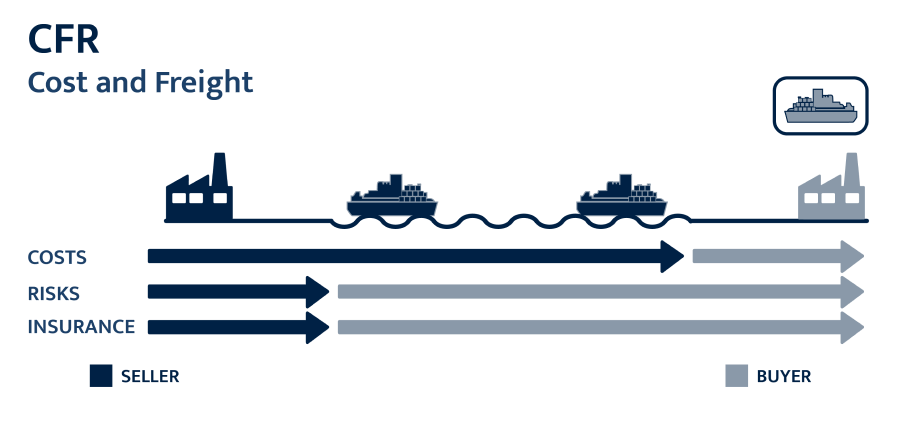
Under CFR, the seller contracts and pays for the freight to a named port of destination. This term has two critical points because risk passes and costs are transferred at different places. The seller delivers the goods when they have been loaded on board the vessel. The risk of loss or damage to the goods passes from the seller to the buyer once the goods are on board the vessel. The seller is responsible to contract and pay for the costs and freight necessary to bring the goods to the named destination port. This term may only be used for goods that are being transported by sea or inland waterway.
- Carriage to be arranged by the seller.
- Risk transfers from the seller to the buyer when the goods have been loaded on board the vessel.
- Cost transfers from the seller to the buyer at the named destination port.
- Alıcı, malları ithalat için gümrükleme, her türlü vergiyi ödeme ve herhangi bir ithalat gümrük formalitesini yerine getirme yükümlülüğüne sahiptir.
Note: The buyer has the obligation to clear the goods for import, pay any duty and carry out any import customs formalities.
Note: CFR may be inappropriate when goods are handed over to the carrier before they are on board the vessel, such as containerized goods that are typically delivered to a terminal. In these situations, the CPT term should be used.
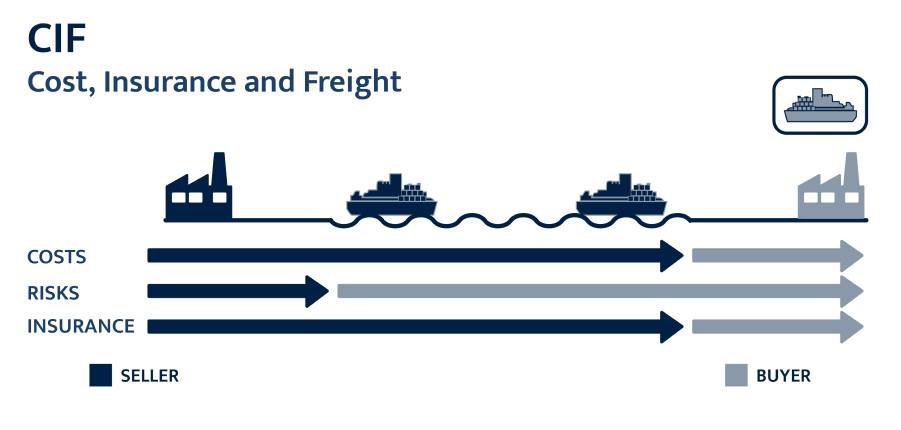
Under CIF, the seller contracts and pays for the freight to a named port of destination, as well as obtaining minimum coverage insurance. This term has two critical points because risk passes and costs are transferred at different places. The seller delivers the goods when they have been loaded on board the vessel. The risk of loss or damage to the goods passes from the seller to the buyer once the goods are on board the vessel. The seller is responsible to contract and pay for the costs and freight necessary to bring the goods to the named destination port. Under the CIF term, the seller is also responsible to procure minimum coverage marine insurance against the buyer’s risk of loss/damage to the goods during carriage. Should the buyer require greater insurance protection, they would either need to agree expressly with the seller or make its own extra insurance arrangements. This term may only be used for goods that are being transported by sea or inland waterway.
- Carriage and minimum insurance to be arranged by the seller.
- Risk transfers from the seller to the buyer when the goods have been loaded on board the vessel.
- Cost transfers from the seller to the buyer at the named port of destination.
Note: The buyer has the obligation to clear the goods for import, pay any duty and carry out any import customs formalities.
Note: CIF may be inappropriate when goods are handed over to the carrier before they are on board the vessel, such as containerized goods that are typically delivered to a terminal. In these situations, the CIP term should be used.
Suggested posts

Pallet Types, Dimensions and Container Arrangement
A pallet is an important logistics equipment in transportation. Pallets are portable, solid platforms those are flat and able to carry the load. Different types of pallets can be used to stack, store, consolidate or transport goods. Pallets increase operational efficiency in the warehouse by allowing stacked goods to be moved easily using machines or tools such as forklifts and pallet trucks.

What are ICC Incoterms? (ICC) Trading Standards for International Transactions
Incoterms are a set of internationally accepted terms that describe the responsibilities and obligations of the parties for the carriage of goods. Incoterms are used so that the division of the transport cost and the risks associated with the international transport and delivery of goods can be clearly determined between the seller and the buyer.

Differences Between Procurement and Purchasing
From past to present, companies have developed various methodologies to ensure optimum supply of materials and services. These methodologies can be seen in systems such as software systems, e-procurement, e-purchasing, e-commerce systems used by companies. What needs to be understood before examining these systems is the differences between sourcing and purchasing. Although these two processes seem to be basically similar or intertwined, there are some distinctive differences.

